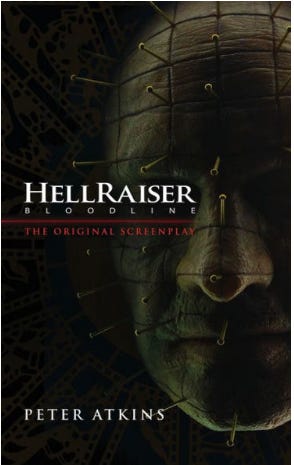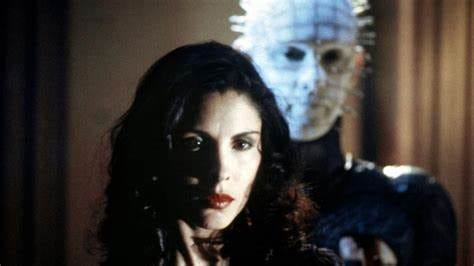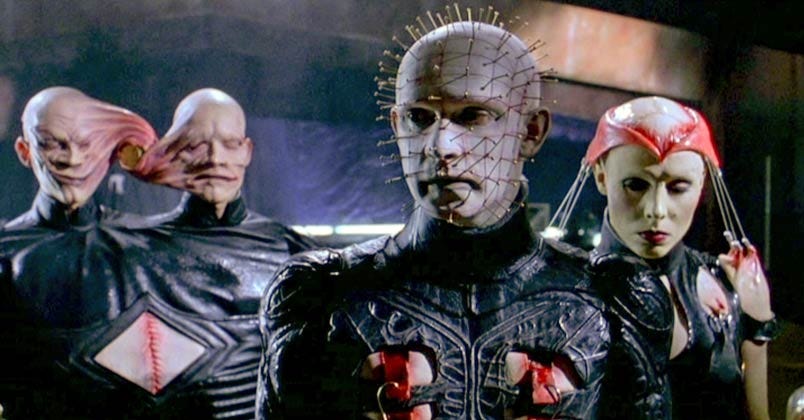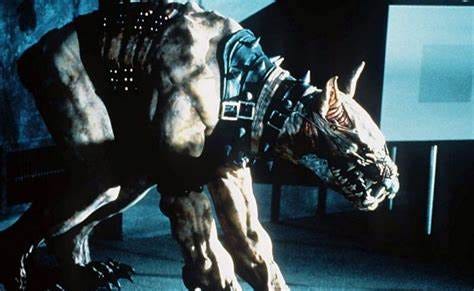Hellraiser: Bloodline
Original Screenplay vs The movie
For the record Hellraiser: Bloodline(the 4th installment in the Hellraiser franchise) is my third favorite of the series behind parts 1 and 2 and right ahead of 3. It has its flaws, but I did enjoy the story as a whole as well as the concept of exploring the origins of the lament configuration created by a French toymaker named Phillip Lemarchand in 1784 and how his bloodline was cursed. Unfairly, Bloodline is also referred to as Hellraiser in space as the last act that takes place in the future on a space station but that is only one third of the movie.
However, I would hear how there was much more to the story and there were more ideas that were left out. Due to studio interference the production was rushed, the budget cut and many of the ideas were left out. This caused director Kevin Yahger to quite before the movie was finished and Joe Chapelle finished the production. Yeager was to receive director’s credit but opted to take the pseudonym Alan Smythe as he was disgusted with the end result and the constant badgering by the Weinstein brother who held the movie rights.
Recently Peter Atkins who wrote the screenplay, released the original screenplay as a book to show the fans what the movie could have looked like. I was excited to get a copy as I purchased it online on the Barnes and Noble website, though you can, also, purchase it on Amazon. I have now finished the book so here is my take. As most of you know Bloodline has three acts to it; 1784 France following Phillip Lemarchand, 1996 New York City following John Merchant and the year 2204 in outer space following Paul Merchant (all played by the same actor, Bruce Ramsey). The only difference there between the screenplay and movie is that in the movie, we briefly start in the future when Paul Merchant is detained by the military space police. He goes on to tell one of the soldiers, by the name of Rimmer, the whole family story. Then we go back to the late 18th century France as Paul Merchant narrates the whole story. In the screenplay we just start off in France with no narration from merchant.
Going forward with this comparison I will break down each act and then give my final analysis.
Act 1: 1784 France.
In this act there is a lot more added to the screenplay. Both the screenplay and the movie start off the same as we are introduced to Phillip Lemarchand as he is constructed the very first puzzle box and soon delivers the box known as the lament configuration to a French aristocrat known for dabbling into black magic named Duc De’lisle. Alongside De’lisle is his apprentice, Jacques. The main difference here is that in the movie De’Lisle uses the box to summon a demon, the princess Angelique, but in the screenplay, Angelique has already been summoned, and it is her that secretly requested De’Lisle to have the box constructed. The infamous line stated by De’Lisle, “Remember Jacques, a summoned demon is yours to command as long as you do not stand in Hell’s way”, appears in both movie and screenplay.
In the movie Phillip, undetected witnesses from outside peering through the window as Delisle and Jacques summon Angelique by using a fresh corpse of a prostitute along with the box. In the book a group of local thrill seekers attend an event at De’lisle’s home where they are presented with the box. Angelique plays a game with them. Every time one of the participants solves a stage of the box, she removes a layer of clothing. Of course, when the box is fully solved the guests are all tortured by hooks and chains and are transformed into Cenobites though much different from what we see other Cenobites look like as they resemble clowns and jugglers. Both scenes, Phillip is horrified but what his box has done.
The rest of this act plays out similar in that Phillip tries to build a new box to reverse what he has done known as the Elysium configuration and is killed towards the end by Angelique and Jacques. De’lisle is also killed as well, in the screenplay by Angelique as De’Lisle attempts to betray her in the movie we are not certain a sit could have been Jacques who wants Angelique for himself. Also, in both scenarios, Phillip has a wife, Genevieve who is with child, She survives both so the bloodline can continue. Though in the screenplay she is nearly killed by Angelique who wants to stop the bloodline.
So, the screenplay gives us more of Angelique who is a fan favorite. There is, also, a sexual tension between her and Phillip which kind of goes back to the pain and pleasure aspects along with desire established in the first two movies and Clive Barker’s novella, The Hellbound Heart.
Act 2: 1996 New York.
In act two, we are introduced to John Merchant, an architect who has designed a new building with designs similar to the Lament configuration. We see this building at the very end of Hellraiser 3. Merchant is married and has a young son but is haunted by nightmares and visions. Visions that influenced his drawings and designs. In his nightmares he is being both haunted and seduced by Angelique who is still on Earth and hasn’t aged a day. The same goes for Jacques. This is the act where we see Pinhead who along with Angelique force John Merchant to finish his work a create a portal to Hell that can never be closed. Merchant double crosses them and is killed but his wife and son survive. We are also introduced to a new Cenobite, the Chatterer beast which is part Chatterer from the first two films and a rabid canine.
There really isn’t a whole lot different with the screenplay and the movie. First, in the scene where Angelique discovers that the bloodline of the toymaker has survived and wished to travel to New York to see him, Jacques objects and as he is standing in Hell’s way is killed by Angelique. In the movie, she simply slices him several times before he is killed. In the screenplay she uses her powers to age Jacques to is natural age, probably the same powers she had used to keep him young. Keep in mind Jacques is well over two hundred years old at this point and how the scene is described reminds me of the scene in Indiana Jones and the Last Crusade where the villain drinks from the wrong cup and ages rapidly before during to bones and dust, you all remember that famous line, “He chose poorly”. That would have been a much cooler kill than in the movie. My guess is that they had to scrap that idea when the budget was cut.
The other difference is that Angelique and Pinhead have a much more adversarial relationship with each other. That tension is somewhat explored in the movie, but the screenplay goes further with it. Angelique represents the old guard that likes to rely on amusement and seduction whereas Pinhead represents the new guard that relies more on fear and pain. At one point Angelique even attempts to double cross Pinhead and she is sent to hell by him.
Other than that, the second act plays out the same with more mention of Merchant; s dreams involving his grandmother warning him about the family curse and the ending scene of act 2 in the screenplay ends with his wife Bobbi and their son, Jack sitting alone in their apartment with Bobbi explaining to their son that everything will be alright.
Act 3: 2204 Outer Space on a space station
Between the original screenplay and the movie, there are quite a few differences. In the movie Paul Merchant has evacuated his crew leaving himself alone on the station he has designed. Taking it out of Earth’s orbit, Merchant uses special gloves with a remote control to an android who opens the box in a confined area of the space station releasing the Cenobites including Pinhead, Anjelique who is now in Cenobite form, the Chatterer beast and two twin cenobites who are conjoined together. Space marines or police board the ship and arrest Merchant and is interrogated by one of the soldiers whose name is Rimmer. Paul Merchant then tells her the whole story of his bloodline as I mentioned earlier.
In the screenplay, however, Merchant is not alone on the station. Assisting him on his mission is the station administrator by the name of Corrine Cotton, a young woman we would assume is a descendent of Kirstie Cotton from the first two Hellraiser movies. This is brilliant as it brings the first four movies full circle by merging the Cotton family storyline with the Lemarchand story line. It would have been no problem to cast Ashley Laurence as Corrine playing a descendent of Kirsty, the role in which she originated.
The ship is still boarded by the military, but a few are actually government officials. There is no interrogation or exposition given by Merchant as this whole screenplay doesn’t jump back and forth in the timelines. Rimmer is a much more minor character and is one of the first killed off. The other personal are killed off one by one much like in the movie and the kills are pretty similar in the way they are described.
Also, in the screenplay Angelique attempts to seduce Paul Merchant but unlike his ancestors, Merchant does not succumb to the temptations.
Another big difference is that in the movie, Merchant escapes the station with Rimmer in a shuttle as the space station transforms into one giant box symbolizing the Elysium configuration and explodes, trapping and destroying Pinhead and the Cenobites. But in the screenplay, it is Corrine who is the sole survivor escaping in the shuttle as Paul merchant stays behind to sacrifice himself in order to see his mission accomplished.
Final Thoughts:
Overall, I wished the original screenplay could have been used for the movie. They might not have been able to use everything but the expanded first act would have added so much more depth to the story and the characters. The third act would have been so much more impactful by having the Corrine Cotton character present and Paul Merchant’s sacrifice would have made it more poetic.
My only critiques of the screenplay is the scene where De’lisle and Jacques murder a prostitute and summon Angelique which is very graphic and epic scene was not included in the story.
The other critique involves Corrine Cotton. Whereas I was pleasantly surprised this character was written in. I am somewhat dumbfounded as to why there was no mention in the screenplay of Corrine’s family origins and her family’s history with the box. Corrine herself is unaware of what Paul is doing or why he is even doing it. It would seem to me that she would know and would speak to her motivation for assisting him and staying on the ship. Instead, it would appear that her only motivation was that she was somewhat smitten with Merchant which kind of does a disservice to the character. I am not sure why this was done? But her character’s history and motivation should have been explored more. Perhaps it would have had the studio not interfered with this movie.
As it stands, I still enjoyed the finished product of the movie giving it an 8/10 but could have gotten at least a 9/10 had the writer and director been allowed to make the movie they wanted in the first place. Maybe they can do a remake and release it a special three-part episode series, with each episode talking place in the three different time eras.
So, if you are a big Hellraiser fan as I am, please get yourself a copy of the book. I think you will enjoy it.










I like Bloodline as well but it does kinda get hokey towards the end. My favorite part of 4 is the origin of the box and how they summon Angelique and how evil/demented she is. I could have watched an entire film about that era and her. Honestly, I'm surprised none of the other films has gone back to that theme or resurrected her as a character. Also, totally agree about the Kirstie Cotton tie-in - that would have been great and made the ending of the film much less hokey.
Amazing, the way you have written it makes me want to rewatch it 🩷😭🫶🏻